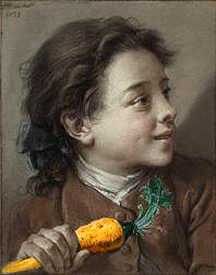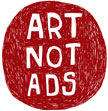6.05.2005
One of the first posts here at the revolution was about the creation of independently produced audio guides. I've seen a few more references to this idea on the web since then, and now there's an article about it in the New York Times.
Not only would this be a fun project, but a great one to exchange between schools.
The entire text of the article appears in the below in the comments.
Tags: Art History, Collaborative, Podcasts
1 Comment:
Subscribe to:
Post Comments (Atom)















By RANDY KENNEDY
Published: May 28, 2005
If you soak up the Jackson Pollocks at the Museum of Modern Art while listening to the museum's official rented $5 audio guide, you will hear informative but slightly dry quotations from the artist and commentary from a renowned curator. ("The grand scale and apparently reckless approach seem wholly American.")
But the other day, a college student, Malena Negrao, stood in front of Pollock's "Echo Number 25," and her audio guide featured something a little more lively. "Now, let's talk about this painting sexually," a man's deep voice said. "What do you see in this painting?"
A woman, giggling, responded on the audio track: "Oh my God! You're such a pervert. I can't even say what that - am I allowed to say what that looks like?"
The exchange sounded a lot more like MTV than Modern Art 101, but for Ms. Negrao it had a few things to recommend it. It was free. It didn't involve the museum's audio device, which resembles a cellphone crossed with a nightstick. And best of all, it was slightly subversive: an unofficial, homemade and thoroughly irreverent audio guide to MoMA, downloaded onto her own iPod.
The creators of this guide, David Gilbert, a professor of communication at Marymount Manhattan College, and a group of his students, describe it on their Web site as a way to "hack the gallery experience" or "remix MoMa," which they do with a distinctly collegiate blend of irony, pop music and heavy breathing. It is one of the newest adaptations in the world of podcasting - downloading radio shows, music and kitchen-sink audio to an MP3 player.
Specifically, these museum guides are an outgrowth of a recent podcasting trend called "sound seeing," in which people record narrations of their travels - walking on the beach, wandering through the French Quarter - and upload them onto the Internet for others to enjoy. In that spirit, the creators of the unauthorized guides to the Modern have also invited anyone interested to submit his or her own tour for inclusion on the project's Web site, mod.blogs.com/art_mobs. (Instructions are on the Web site.)
In the museum world, where the popularity of audio tours has grown tremendously over the last decade, the use of commercial MP3 players seems to be catching on. Officials at the Walker Art Center in Minneapolis have discussed putting their new audio guide material on the Web for downloading to portable players. Last year, the Mori Art Museum in Tokyo lent viewers iPods to use as audio guides for one exhibition, and Apple Computer has helped the Château de Chenonceau in the Loire Valley of France do the same thing, using the sonorous voice of the actor Michael Lonsdale.
But the rise of podcasting is now enabling museumgoers not simply to enjoy audio guides on a sleeker-looking device but also to concoct their own guides and tours. A New York art Web site, woostercollective.com, recently made a sound-seeing tour of the Jean-Michel Basquiat retrospective at the Brooklyn Museum, which the Web site's creators made in hushed tones while wandering through the show, sometimes quoting from the museum's official audio guide, which they listened to as they chatted.
At Marymount, on the Upper East Side, Dr. Gilbert said he was partly inspired to create the unofficial guides after listening to the museum's audio tours for children, which he found much more entertaining and engaging than the new ones recently introduced for grown-ups.
But Dr. Gilbert said his larger point was to try to teach his students to stop being passive information consumers - whether through television, radio or an official audio guide - and to take more control, using as his model the guru of so-called remix culture, Lawrence Lessig, a professor at Stanford Law School.
"It's not incumbent on us to, you know, praise the art necessarily," Dr. Gilbert said recently at the museum, wearing neon-green sunglasses and leading a group of students through the underground tour. "That's part of the playfulness and fun of this project. If we want to say something irreverent or something scathing about the art, that can come out." (In the name of politeness, the project's Web site does tip its hat to the Modern: "Apologia: We love MoMA. Hackers hack a platform out of respect for it.") Informed about the project last week, museum officials declined to reciprocate with their opinions, but also made no comments about instituting an iPod ban.
So far, the unofficial guides cover only a few of the museum's works - by artists like Pollock, Cindy Sherman, Francis Bacon, Picasso, Max Beckmann and Marc Chagall, whose well-known "I and the Village" comes in for a critical pummeling by Jason Rosenfeld, a Marymount professor of art history, who calls it "the worst, most reductive kind of art" and blames Chagall for all the "ugly menorahs" and tacky stained-glass windows in modern synagogues.
"It's the worst style that ever developed in the history of art," he declares.
A visceral Bacon painting called "Painting" (1946) gets an all-music treatment that sometimes sounds like Metallica. Beckmann receives a dark hip-hop soundtrack. ("If anybody cares/ I'll be in the basement slitting my throat/ Happy New Year.") And the Pollock guide, while mostly sex-obsessed, does include the owner of the deep voice, John Benton, another Marymount communication professor, talking about Pollock's calligraphic technique and his references to Roman art.
But lest any of this become boring, the discussion is also sprinkled with driving guitar riffs from the 1970's song "Peaches," by the Stranglers, along with echo effects and the sound of a woman moaning in pleasure.
"That's not me doing that," stressed Ms. Negrao, a Marymount junior who is one of the women's voices on the Pollock guide. "That's a sound effect."
Last week, as she and her fellow students Liza Pastore, Cheryl Stoever and Aubrey Strickland gathered in a semicircle in front of the Pollock, other museumgoers crowding by would slow down and stare, wondering why the women were laughing and what they were hearing through those familiar white iPod earphones.
Later, in front of Ms. Sherman's "Untitled No. 92," the group roped in a stranger, Ashkan Sahihi, and persuaded him to listen along on one of their iPods to a funny and sometimes silly recorded exchange between students and professors about the photograph, with the soundtrack from the movie "Kill Bill" blasting in the background.
Mr. Sahihi smiled and bobbed his head to the beat and later pronounced the student production much better than the last audio guide he'd heard (and that was an official one narrated by David Bowie).
"Anybody who listens to those guides that you really get in museums," he said, "you get pretty tired because usually it's a very drawn-out explanation of why the museum was willing to pay so much money for a picture."
"This is not just some expensive name telling me about expensive art," he added. "Plus, it's funny."